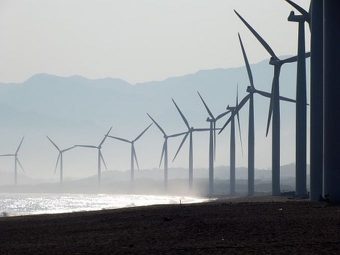
A major wind power project aims to capture the Central Coast’s wind and turn it into electricity. Trident Winds proposes to build a wind farm of 60 to 100 turbines off the coast, from Cayucos to north of Piedras Blancas.
Trident Winds founder Alla Weinstein presented her Seattle-based company’s case for the project June 20 at the Veterans Memorial Building. Before founding Trident, she led the company that developed the WindFloat floating foundation for deep-water offshore installations.
“Demand for energy continues to grow,” she said. “A convergence of factors leads to a need for more renewable energy. The technology is maturing.”
Weinstein said the project would be more than 20 miles offshore, to catch the winds and be out of sight, except from high on Hearst Castle’s hilltop, when lights would probably be seen at night. Together, the 600-foot-tall turbines would produce 1,000 megawatts of electricity. That power would reach the mainland through underwater transmission lines to the PG&E substation in Morro Bay.
The turbines would be tethered to the ocean floor by cables. The area targeted was chosen after weighing the overlapping interests in the area, from fishing grounds to the Point Mugu Missile Range, which impinges on part of the proposed site, and the fiber-optic cable corridor off Los Osos and Morro Bay.
It is outside the boundaries of the Monterey Bay National Marine Sanctuary, but in the migration path of gray and blue whales, elephant seals and other marine mammals. Pelagic birds might not be affected as much as land birds, which frequently fly into the whirling windmill blades on land.
“They navigate by changes in pressure, so they alter their route to fly around the turbines,” Weinstein said. “Pelagic birds are smarter than land birds.”
Environmental organizations filed comments to the initial request, posted on the Bureau of Ocean Energy Management’s website.
Weinstein said the wind off California’s coast represents a potential 112-gigawatt resource, compared to the two gigawatts that Diablo Canyon Nuclear Power Plant produces. According to the California Energy Commission, wind power is projected to fill some of the requirement for 50 percent of California’s Clean Energy and Pollution Reduction Act of 2015, which requires the state to get half of its electrical power from renewable energy sources by 2030. If everything falls into place — the project is subject to 33 permits and leases — it could be operational in 2025, Weinstein said.
Trident was the first company to apply for a lease to build a wind farm off the Central Coast. The land it would be leasing is in federal waters, so the Bureau of Ocean Energy Management is the responsible agency. Statoil, a Norwegian energy company, has since applied to compete for the lease. Weinstein’s presentation was a voluntary effort by Trident. Statoil has not yet offered to make its case to the public.
County Supervisor Bruce Gibson serves on the Bureau of Ocean Energy Management California Intergovernmental Renewable Energy Task Force, the panel of federal, state, local agencies and tribal governments collecting information to advise on decisions about future offshore renewable energy development in federal waters offshore California. He introduced Weinstein.
“The time is right for taking a look at energy offshore,” he said.
Source: sanluisobispo.com

